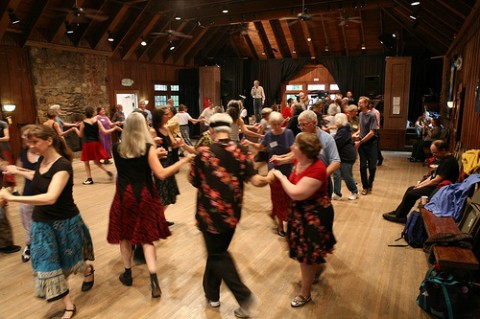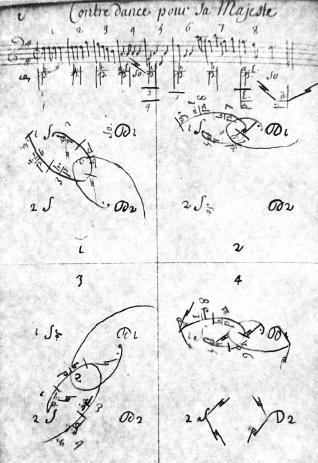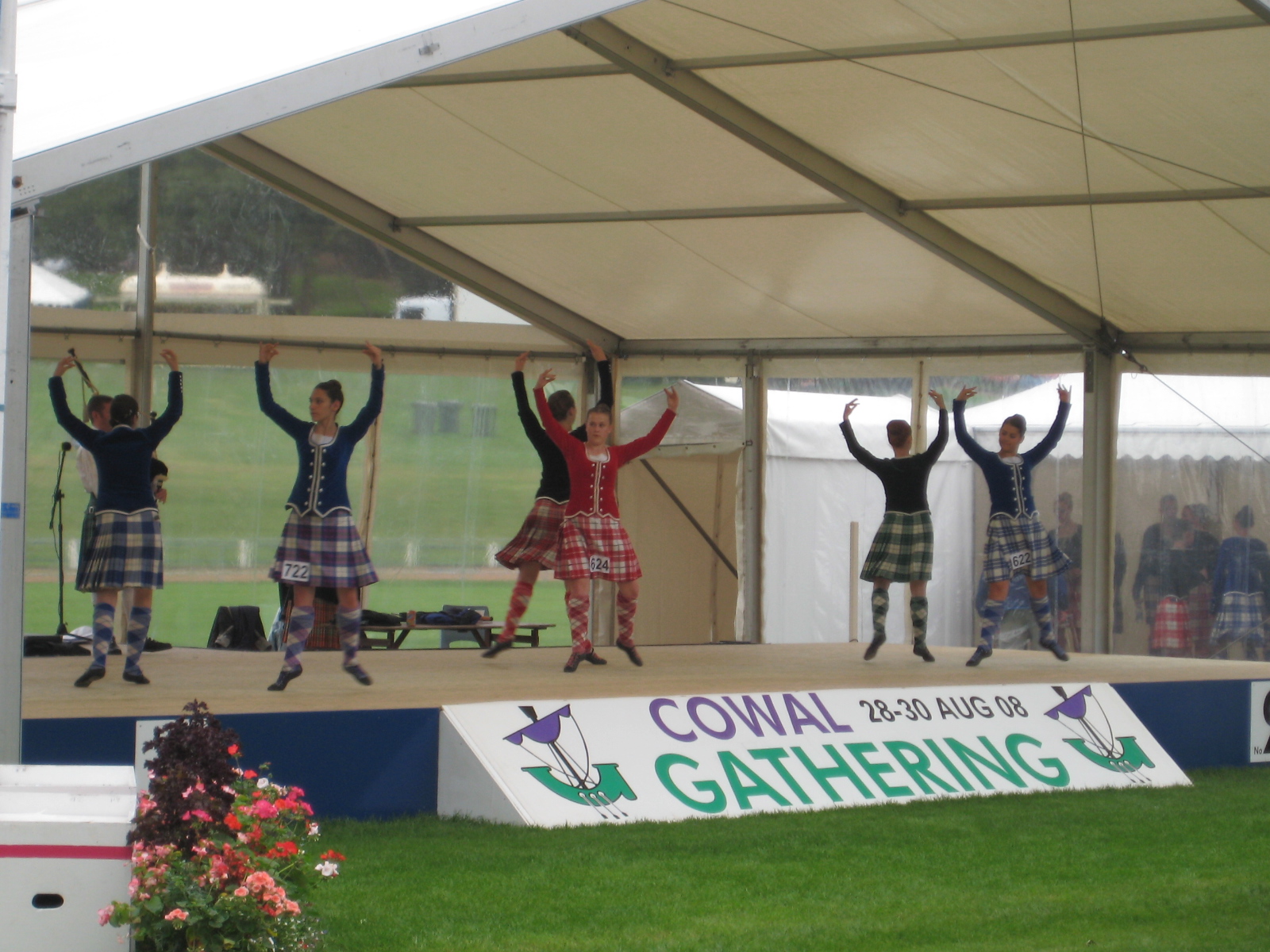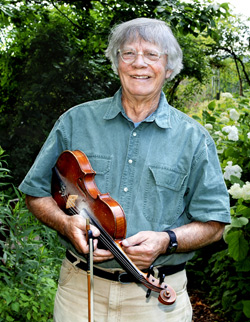|
Dosado
Do-si-do, also spelled dosado, do-se-do, or dos-à-dos, is a dance move found in several forms of social dance, including square dance, contra dance, English country dance, and Scottish country dance. The move involves two dancers approaching each other, passing around one another back-to-back, and returning to their original positions without turning to face each other during the maneuver. It requires coordination and spatial awareness between partners. Description It is a circular movement where two people, who are initially facing each other, walk around each other without or almost without turning, i.e., facing in the same direction (same wall) all the time. In most cases it takes 6–8 counts to complete. The movement is basically defined by as follows: * dancers advance and pass right shoulders, * without turning each dancer moves to the right passing in back of the other dancer. At this moment the partners face away from each other, * then moving backwards dancers pass lef ... [...More Info...] [...Related Items...] OR: [Wikipedia] [Google] [Baidu] |
Square Dance
A square dance is a dance for four couples, or eight dancers in total, arranged in a square, with one couple on each side, facing the middle of the square. Square dances are part of a broad spectrum of dances known by various names: country dances, traditional dances, folk dances, barn dances, ceilidh dances, contra dances, Playford dances, etc. These dances appear in over 100 different formations, of which the Square and the Longways Set are by far the most popular formations. Square dances contain elements from numerous traditional dances including Country dance, English country dances, which were first documented in 17th-century England, and 18th-century French quadrilles and cotillions; square dancing travelled to North America with the European settlers and developed significantly there. Square dancing is done in many different styles all around the world. In some countries and regions, through preservation and repetition, square dances have attained the status of a folk d ... [...More Info...] [...Related Items...] OR: [Wikipedia] [Google] [Baidu] |
Callerlab
CALLERLAB is the international association of square dance callers, and is the largest square dance association in the United States. CALLERLAB provides guidance and education, certifying caller coaches, maintaining standardized lists of calls and definitions, and generally promoting the square dance activity. After some initial work started in 1971, it was officially established in 1974 by several members of the Square Dance Hall of Fame. Callerlab makes it so people can dance anywhere in the world with uniform dance calls. Callers from all over the world, including Saudi Arabia, Japan, Germany, and England, are members of the organization, which hosts and annual convention. The average age of Callerlab members is 65. Functions *Maintains a suggested list of dancing programs, from Mainstream through C-3A. Each program contains a list of standardized square dance calls and concepts, with official definitions. *Provides BMI/ASCAP licensing to its members *Provides liability in ... [...More Info...] [...Related Items...] OR: [Wikipedia] [Google] [Baidu] |
Square Dance
A square dance is a dance for four couples, or eight dancers in total, arranged in a square, with one couple on each side, facing the middle of the square. Square dances are part of a broad spectrum of dances known by various names: country dances, traditional dances, folk dances, barn dances, ceilidh dances, contra dances, Playford dances, etc. These dances appear in over 100 different formations, of which the Square and the Longways Set are by far the most popular formations. Square dances contain elements from numerous traditional dances including Country dance, English country dances, which were first documented in 17th-century England, and 18th-century French quadrilles and cotillions; square dancing travelled to North America with the European settlers and developed significantly there. Square dancing is done in many different styles all around the world. In some countries and regions, through preservation and repetition, square dances have attained the status of a folk d ... [...More Info...] [...Related Items...] OR: [Wikipedia] [Google] [Baidu] |
Glossary Of Partner Dance Terms
This is a list of dance terms that are not names of dances or types of dances. See List of dances and List of dance style categories for those. This glossary lists terms used in various types of ballroom partner dances, leaving out terms of highly evolved or specialized dance forms, such as ballet Ballet () is a type of performance dance that originated during the Italian Renaissance in the fifteenth century and later developed into a concert dance form in France and Russia. It has since become a widespread and highly technical form of ..., tap dancing, and square dancing, which have their own elaborate terminology. See also: * Glossary of ballet terms * Glossary of dance moves Abbreviations *3T – Three Ts *CBL – Cross-body lead *CBM – Contra body movement *CBMP – Contra body movement position *COG – Center of gravity *CPB – Center point of balance *CPP – Counter promenade position *DC – Diagonally to center *DW – Direction of ... [...More Info...] [...Related Items...] OR: [Wikipedia] [Google] [Baidu] |
English Country Dance
A country dance is any of a very large number of social dances of a type that originated in England in the British Isles; it is the repeated execution of a predefined sequence of figures, carefully designed to fit a fixed length of music, performed by a group of people, usually in couples, in one or more sets. The figures involve interaction with your partner and/or with other dancers, usually with a progression so that you dance with everyone in your set. It is common in modern times to have a "caller" who teaches the dance and then calls the figures as you dance. Country dances are done in many different styles. As a musical form written in or time, the contredanse was used by Beethoven and Mozart. Beethoven's 6 Ecosaises WoO83 are dated to 1806. Mozart's 6 Ländlerische Tänze, K.606 are dated to 1791. Introduced to South America by French immigrants, Country Dance had great influence upon Latin American music as contradanza. The ''Anglais'' (from the French word meanin ... [...More Info...] [...Related Items...] OR: [Wikipedia] [Google] [Baidu] |
Contra Dance
Contra dance (also contradance, contra-dance and other variant spellings) is a form of folk dance, folk dancing made up of long lines of couples. It has mixed origins from English country dance, Scottish country dance, and French dance styles in the 17th century. Sometimes described as New England folk dance or Appalachian folk dance, contra dances can be found around the world, but are most common in the United States (periodically held in nearly every state), Canada, and other English-speaking world, Anglophone countries. A contra dance event is a social dance that one can attend without a partner. The dancers Contra dance form, form couples, and the couples form sets of two couples in long lines starting from the stage and going down the length of the dance hall. Throughout the course of a dance, couples progress up and down these lines, dancing with each other couple in the line. The dance is led by a caller (dance), caller who teaches the Contra dance choreography, sequence o ... [...More Info...] [...Related Items...] OR: [Wikipedia] [Google] [Baidu] |
Scottish Highland Dance
Highland dance or Highland dancing () is a style of competitive dancing developed in the Scottish Highlands in the 19th and 20th centuries, in the context of competitions at public events such as the Highland games. It was created from the Gaelic folk dance repertoire, but formalised with the conventions of ballet, and has been subject to influences from outside the Highlands. Highland dancing is often performed with the accompaniment of Highland bagpipe music, and dancers wear specialised shoes called ghillies or pumps. It is now seen at nearly every modern-day Highland games event. Highland dance should not be confused with Scottish country dance, cèilidh dancing, or clog dancing, although they too may be performed at Highland games and like competitions. Basic description of Highland dancing Highland dancing is a competitive and technical dance form requiring technique, stamina, and strength, and is recognised as a sport by the Sport Council of Scotland. In Highland ... [...More Info...] [...Related Items...] OR: [Wikipedia] [Google] [Baidu] |
Genre
Genre () is any style or form of communication in any mode (written, spoken, digital, artistic, etc.) with socially agreed-upon conventions developed over time. In popular usage, it normally describes a category of literature, music, or other forms of art or entertainment, based on some set of stylistic criteria, as in literary genres, film genres, music genres, comics genres, etc. Often, works fit into multiple genres by way of borrowing and recombining these conventions. Stand-alone texts, works, or pieces of communication may have individual styles, but genres are amalgams of these texts based on agreed-upon or socially inferred conventions. Some genres may have rigid, strictly adhered-to guidelines, while others may show great flexibility. The proper use of a specific genre is important for a successful transfer of information ( media-adequacy). Critical discussion of genre perhaps began with a classification system for ancient Greek literature, as set out in Aristotle' ... [...More Info...] [...Related Items...] OR: [Wikipedia] [Google] [Baidu] |
American Callers Association
The American Callers Association (ACA) is the second largest association of square dance callers in the United States. ACA is a non-profit organization with headquarters at Muscle Shoals, Alabama. ACA has members in the United States, Canada, Europe, and New Zealand. Among other things, the organization provides accredited caller training and affordable BMI/ASCAP licensing and liability insurance for dance events. The United States has over 1,900 callers. See also *Callerlab CALLERLAB is the international association of square dance callers, and is the largest square dance association in the United States. CALLERLAB provides guidance and education, certifying caller coaches, maintaining standardized lists of calls a ... References Square dance Dance organizations in the United States Dance in Alabama Muscle Shoals, Alabama {{US-culture-org-stub ... [...More Info...] [...Related Items...] OR: [Wikipedia] [Google] [Baidu] |
Modern Western Square Dance
Modern western square dance (also called western square dance, contemporary western square dance, modern American square dance or modern square dance) is one of two American types of square dancing, along with traditional square dance. As a dance form, modern western square dance grew out of traditional square dance in the American West. The term ''western square dance'', for some, is synonymous with "cowboy dance" or traditional western square dance. Therefore, this article uses the term "modern western square dance" to describe the contemporary non-historical dance which grew out of the traditional dance. Square dancing was the national folk dance of the United States in 1982 and 1983. Modern western square dance, like traditional square dance, is directed by a '' caller''. In modern western square dance the caller strings together a sequence of individual '' square dance calls'' to make a figure or sequence. These calls are the building blocks of the choreography that is ... [...More Info...] [...Related Items...] OR: [Wikipedia] [Google] [Baidu] |
Contra Dance
Contra dance (also contradance, contra-dance and other variant spellings) is a form of folk dance, folk dancing made up of long lines of couples. It has mixed origins from English country dance, Scottish country dance, and French dance styles in the 17th century. Sometimes described as New England folk dance or Appalachian folk dance, contra dances can be found around the world, but are most common in the United States (periodically held in nearly every state), Canada, and other English-speaking world, Anglophone countries. A contra dance event is a social dance that one can attend without a partner. The dancers Contra dance form, form couples, and the couples form sets of two couples in long lines starting from the stage and going down the length of the dance hall. Throughout the course of a dance, couples progress up and down these lines, dancing with each other couple in the line. The dance is led by a caller (dance), caller who teaches the Contra dance choreography, sequence o ... [...More Info...] [...Related Items...] OR: [Wikipedia] [Google] [Baidu] |
Vis-à-vis
Vis-à-vis may refer to: * Vis-à-vis, a French expression in English, literally "face to face (with)", meaning in comparison with or in relation to * ''Vis-à-vis'' (album), by Karol Mikloš, 2002 * Vis-à-vis (carriage), a type of horse-drawn carriage * ''Vis a vis'' (TV series), a Spanish TV series * "Vis à Vis" (''Star Trek: Voyager''), an episode of the TV series See also * Viz (other) {{disambiguation ... [...More Info...] [...Related Items...] OR: [Wikipedia] [Google] [Baidu] |






